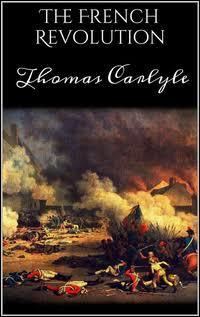7.8 /10 1 Votes7.8
Language English Originally published 1837 Publishers Chapman & Hall, London | 3.9/5 Goodreads Publication date 1837 | |||||||||||||||||||||||||||||||||
 | ||||||||||||||||||||||||||||||||||
Country United Kingdom of Great Britain and Ireland Similar Works by Thomas Carlyle, French Revolution books, Revolution books | ||||||||||||||||||||||||||||||||||
The French Revolution: A History was written by the Scottish essayist, philosopher, and historian Thomas Carlyle. The three-volume work, first published in 1837 (with a revised edition in print by 1857), charts the course of the French Revolution from 1789 to the height of the Reign of Terror (1793–94) and culminates in 1795. A massive undertaking which draws together a wide variety of sources, Carlyle's history—despite the unusual style in which it is written—is considered to be an authoritative account of the early course of the Revolution.
Contents
Production and reception
John Stuart Mill, a friend of Carlyle's, found himself caught up in other projects and unable to meet the terms of a contract he had signed with his publisher for a history of the French Revolution. Mill proposed that Carlyle produce the work instead; Mill even sent his friend a library of books and other materials concerning the Revolution, and by 1834 Carlyle was working furiously on the project. When he had completed the first volume, Carlyle sent his only complete manuscript to Mill. While in Mill's care the manuscript was destroyed, according to Mill by a careless household maid who mistook it for trash and used it as a firelighter. Carlyle then rewrote the entire manuscript, achieving what he described as a book that came "direct and flamingly from the heart."
The book immediately established Carlyle's reputation as an important 19th century intellectual. It also served as a major influence on a number of his contemporaries, most notably, perhaps, Charles Dickens, who compulsively read and re-read the book while producing A Tale of Two Cities. The book was closely studied by Mark Twain during the last year of his life, and it was reported to be the last book he read before his death.
Style
As a historical account, The French Revolution has been both enthusiastically praised and bitterly criticized for its style of writing, which is highly unorthodox within historiography. Most historians attempt to assume a neutral, detached tone of writing, in the tradition of Edward Gibbon. Carlyle unfolds his history by often writing in present-tense first-person plural: as though he and the reader were observers, indeed almost participants, on the streets of Paris at the fall of the Bastille or the public execution of Louis XVI. This, naturally, involves the reader by simulating the history itself instead of solely recounting historical events.
Carlyle further augments this dramatic effect by employing a style of prose poetry that makes extensive use of personification and metaphor—a style that critics have called exaggerated, excessive, and irritating. Supporters, on the other hand, often label it as ingenious. John D. Rosenberg, a Professor of humanities at Columbia University and a member of the latter camp, has commented that Carlyle writes "as if he were a witness-survivor of the Apocalypse. [...] Much of the power of The French Revolution lies in the shock of its transpositions, the explosive interpenetration of modern fact and ancient myth, of journalism and Scripture." Take, for example, Carlyle's recounting of the death of Robespierre under the axe of the Guillotine:
Thus, Carlyle invents for himself a style that combines epic poetry with philosophical treatise, exuberant story-telling with scrupulous attention to historical fact. The result is a work of history that is perhaps entirely unique, and one that is still in print nearly 200 years after it was first published.
